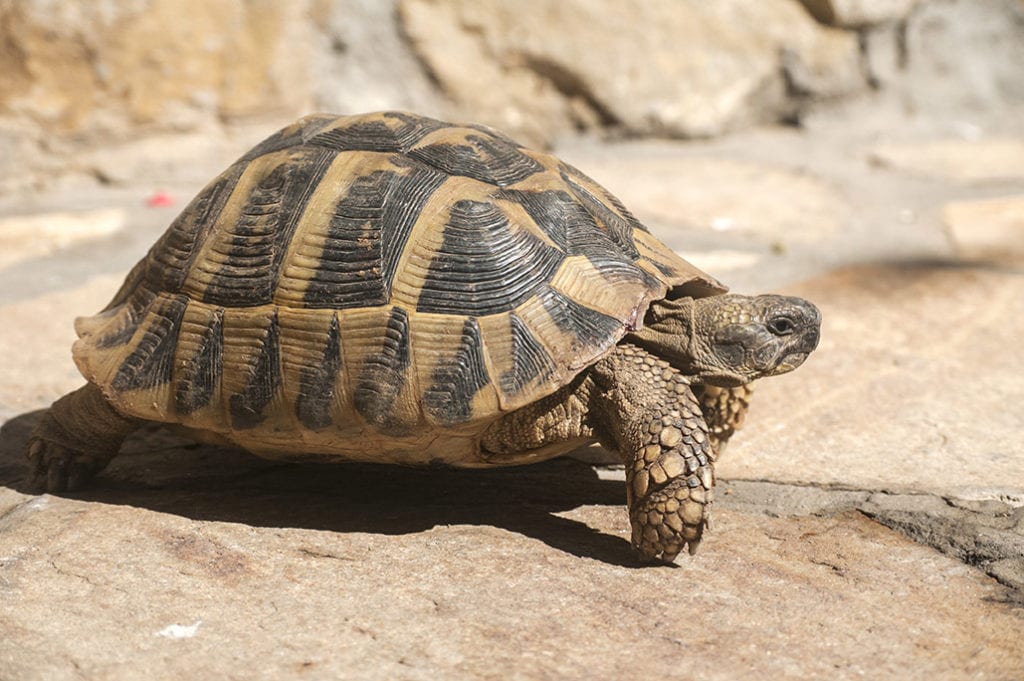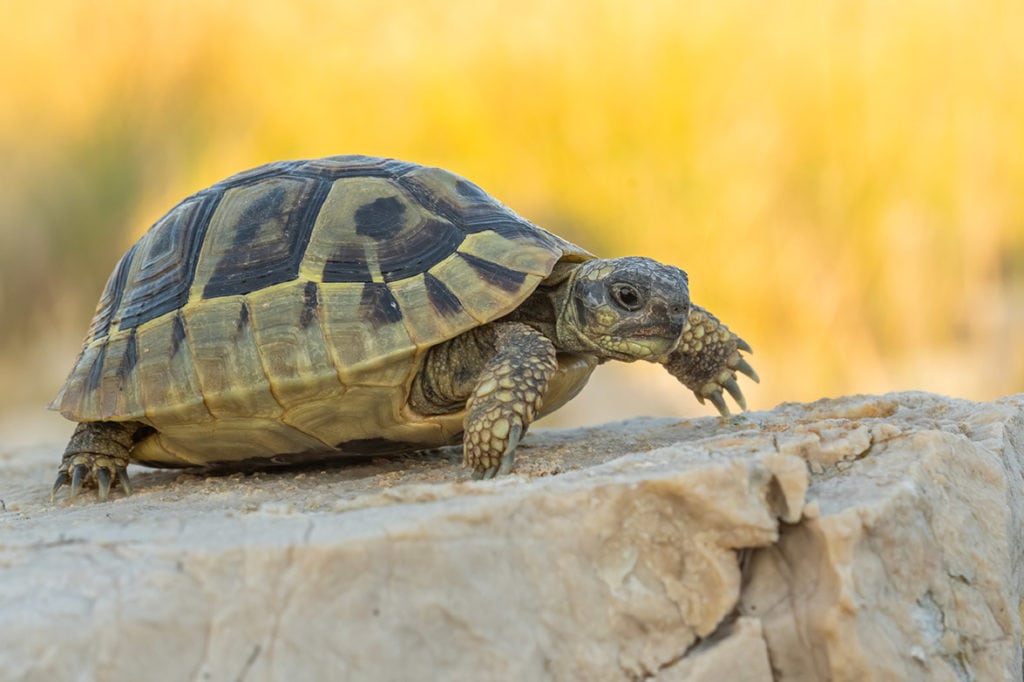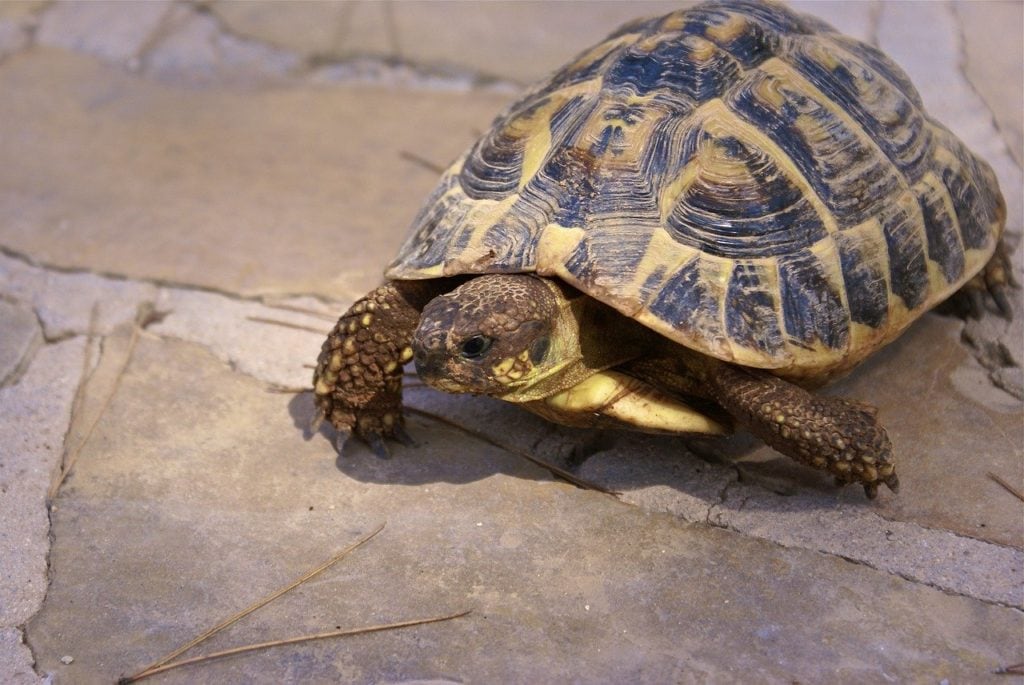

One of the most popular tortoises kept as pets, the Hermann’s Tortoise is an amiable and enjoyable pet to keep. With a natural habitat that spans the Mediterranean region of Europe, these tortoises prefer mild weather with temperatures in the low 80s during the day. If the climate where you live is similar, then you should be able to keep a Hermann’s Tortoise with little effort since they prefer to remain outside. In other climates, keeping a Hermann’s Tortoise as a pet can prove difficult as they don’t do as well indoors.

Quick Facts About Hermann’s Tortoises
| Species Name: | Testudo hermanni |
| Family: | Testudinidae |
| Care Level: | Moderate |
| Temperature: | 60-85 Fahrenheit |
| Temperament: | Friendly, gentle, active |
| Color Form: | Brown and yellow |
| Lifespan: | 30-75 years |
| Size: | 4.5”-11” |
| Diet: | Mostly plant matter |
| Minimum Tank Size: | 24” X 48” |
| Tank Set-Up: | Outdoor is best |
| Compatibility: | Intermediate and above |
Hermann’s Tortoise Overview
The Hermann’s Tortoise is a friendly and docile tortoise that isn’t known to bite, other than when forced to defend itself. It’s this gentle nature that makes them such good pets and has earned them so many admirers. But their popularity doesn’t necessarily mean they’re a good fit for everyone.
If you don’t live in a temperate climate where the temperature remains below 90º F in the heat of summer, then you’ll probably need to house your Hermann’s Tortoise indoors. The problem with this is that these tortoises have some serious space needs, even though they’re not terribly large for tortoises. Outside, offering ample space isn’t too difficult. But if you have to house your tortoise inside, you’ll be giving up a good chunk of space somewhere. An enclosure that’s 2’ x 4’ is about the smallest you can get away with, and even that is cramped accommodations for a Hermann’s Tortoise. You’ll also have to choose a very deep tank since these tortoises love to dig and burrow.
Even housing a Hermann’s Tortoise outside comes with its share of headaches. As mentioned, these tortoises love to dig, and they’re great at it. You’ll need to dig down when building the enclosure, making sure the walls go several feet into the earth. Fail to insert them deep enough and your tortoise will escape like a jailbreak, digging its way to freedom underneath your walls.

How Much Do Hermann’s Tortoises Cost?
The price of Hermann’s Tortoises ranges quite a bit, depending on how old the tortoise is and where you purchase it. Be aware, many Hermann’s Tortoises on the pet market have been captured in the wild, reducing wild numbers. Purchase your tortoise from a reputable breeder to ensure that it’s captive-bred and isn’t harming the natural population of Hermann’s Tortoises.
On average, you’ll spend between $150 and $500 for a healthy Hermann’s Tortoise from a reputable breeder. These are babies and juveniles. Adults cost more since the cost of care must be added to the purchasing price. Plus, adults are already proven to be healthy. You never know what your juvenile or baby tortoise might turn out like, though with proper care, it should turn out to be a healthy adult too, barring unfortunate circumstances.
Typical Behavior & Temperament
Hermann’s Tortoises aren’t as slow as you might expect. These are active little tortoises, and they’re on the go a lot. When they’re not, they tend to sunbathe, but the rest of the time, you’ll find them digging, foraging, and even running. They’re considered to be very friendly and docile, but you still shouldn’t try to handle yours. Hermann’s Tortoises don’t like to be picked up and held. They clearly prefer to keep all four legs on the ground where they feel secure, and if you pick one up, it won’t hesitate to let you know.

Appearance & Varieties
There are two main varieties of the Hermann’s Tortoise. The western variety’s shell is domed much higher than the eastern type. Additionally, the Western Hermann’s Tortoise has vibrant shell coloring, where the yellows are rich, golden, and sometimes even orange. Even the blacks on a Western Hermann’s Tortoise’s shell are deep, while the eastern variety has much more subdued coloring that looks faded. The yellows are more of a dull olive and the blacks are faded and even appear frayed.
Counting forward from the rear, on the third scute in the center, Eastern Hermann’s Tortoises will generally lack the black mark that’s present in the same spot on a western variety. However, the eastern variety tends to be a larger turtle overall. On the underside, Western Hermann’s Tortoises will display two jet-black markings that run the full length of the body on either side, separated in the center. While the eastern variety also has black marking on its undersides, they’re generally splotchy and undefined.

How to Take Care of a Hermann’s Tortoise
Habitat, Tank Conditions & Setup
Hermann’s Tortoises do best when allowed to live outside. Not only do they require lots of space, but they also like to dig, run, and forage. It’s hard to provide enough space to keep one healthy indoors, but it can be done. Still, it’s best if you live in a climate temperate enough to house your tortoise outdoors. They will hibernate through the colder parts of winter, and if it’s too cold where you’re at, your tortoise can be brought inside during this time. However, temperatures in the 90s and higher during the summer months are just too hot for a Hermann’s Tortoise.
Enclosure
If you’re keeping your tortoise outside, you’ll want to ensure that you bury the walls several feet deep to prevent your tortoise from burrowing its way out underneath. You’ll also need to provide a shaded area where your turtle can get out of the sun to escape the heat. For indoor enclosures, you’ll need a large aquarium that’s no less than 2’ x 4’ and as tall as possible so your tortoise can dig.
Temperature
Daytime temperatures should hover in the 80s. At night, temperatures can drop down to 65º F, but these tortoises don’t do well in temperatures much lower than that. For indoor tortoises, a heat lamp is the best way to achieve this temperature. Plus, it offers your tortoise a great basking area.
Lighting
For outdoor tortoises, no thought needs to be given to lighting; the sun will suffice. Indoor tortoises will require a UVB bulb to ensure they’re getting the vitamins they’d usually be getting from sunlight.
Humidity
You don’t have to give humidity much consideration with a Hermann’s Tortoise. So long as humidity remains 25% or higher, your tortoise should be fine.
Substrate
As stated, Hermann’s Tortoises love to dig and burrow. Outside, this is no problem, so long as the walls of its enclosure are buried deeper than it digs. But in an indoor enclosure, you’ll have a hard time providing enough substrate for your turtle to properly burrow. Still, you should use as much substrate as possible given the size of your tank. They don’t need any room to climb, so you can fill the enclosure halfway up or more with substrate. Most owners prefer a mix of sand, soil, and cypress bark for substrate.

Can Hermann’s Tortoises Be Housed Together?
It’s a common desire to house several tortoises in the same enclosure. However, with Hermann’s Tortoises, that’s simply not a good idea. These tortoises can get very violent with each other; particularly around mating.
Males will aggressively attack other males to keep them out of their territory, and damage often results. Moreover, males will also attack females, ramming into them during courtship and potentially even hurting them in the process. You should only put two Hermann’s Tortoises together when you’re trying to mate them. Otherwise, these tortoises are best kept in solitary enclosures to avoid fighting that can lead to injury.

What to Feed Your Hermann’s Tortoise
These tortoises are omnivores, but just barely. The vast majority of their diet consists of plant matter, including fruits, vegetables, flowers, weeds, grasses, and more. However, they can also eat the occasional insect or snail. If your tortoise lives outside, then it will find and forage the insects on its own. For indoor tortoises, an earthworm here and there will provide ample protein, and you can dip it in a vitamin supplement to ensure your tortoise’s nutrition is complete.
Most of your tortoise’s diet will be made up of plant matter, such as:
- Grasses
- Weeds
- Leafy lettuce
- Carrots
- Cabbage
- Apples
- Dandelions
- Parsley
- Peppers
- Clover
- Coriander
- Kale
- Broccoli
- Parsnip
- Watercress

Keeping Your Hermann’s Tortoise Healthy
The main key to keeping your Hermann’s Tortoise healthy is to provide the right living conditions, which means ample space, the proper temperature, and adequate nutrition. Next, you want to avoid injury by keeping these tortoises in their own enclosures. Even so, there are still a few illnesses that these tortoises are susceptible to.
Cloacal Prolapse – This is when the bladder is blocked by a stone or hardened urate. It’s caused by dehydration most often and requires veterinary care for treatment.
Metabolic Bone Disease – Also known as soft shell disease, the most obvious symptom of metabolic bone disease in turtles is the shell becoming soft. However, there are other symptoms as well, including anorexia and general weakness. You should first notice your turtle is moving strangely and you might see behavioral changes. A veterinarian should be contacted immediately if you suspect your tortoise may have metabolic bone disease.
Respiratory Infection – Either the lower or upper respiratory tract can become infected in a tortoise, and it’s often lethal. In fact, it takes just a few hours for a respiratory infection to become fatal because turtles have no diaphragm and can’t cough to remove mucus from the lungs. Instead, when mucus builds up, a turtle will drown in it. If you can spot it early enough, treatment is possible, but sudden onset cases are deadly most of the time.
Breeding
As polygynandrous reptiles, male and female Hermann’s Tortoises will both take on multiple mates during a single breeding season. But mating can be dangerous for these tortoises. Males become very aggressive and will attack females by chasing and ramming into them, which can hurt the female. Breeding generally starts in late February when the tortoises awake from their winter hibernation. Females lay 2-12 eggs, buried only a few inches into the soil. One or two clutches can be laid in a season. The eggs will take about 3 months to incubate, generally hatching in August and September.

Is a Hermann’s Tortoise Suitable For You?
There’s one easy way to know if a Hermann’s Tortoise is right for you: the weather! These tortoises will thrive when kept outside, but will never do quite as well indoors with limited space and artificial light. However, you can’t keep a Hermann’s Tortoise outside if the climate isn’t right. These tortoises won’t withstand temperatures climbing into the 90s, so you must have temperate summers in your location. If not, then you can still keep a Hermann’s Tortoise, but you’ll have to sacrifice a ton of indoor space and your tortoise will never be as healthy and happy as it could be outside.
Featured Image Credit: Rudmer Zwerver, Shutterstock
An avid outdoorsman, Dean spends much of his time adventuring through the diverse terrain of the southwest United States with his closest companion, his dog, Gohan. He gains experience on a full-time journey of exploration. For Dean, few passions lie closer to his heart than learning. An apt researcher and reader, he loves to investigate interesting topics such as history, economics, relationships, pets, politics, and more.






